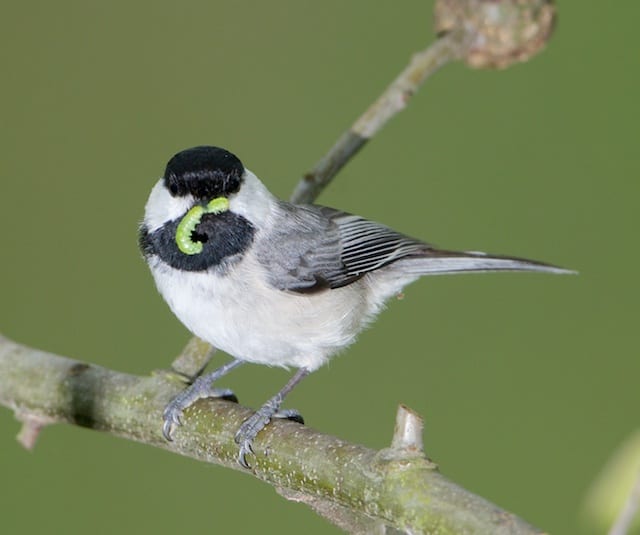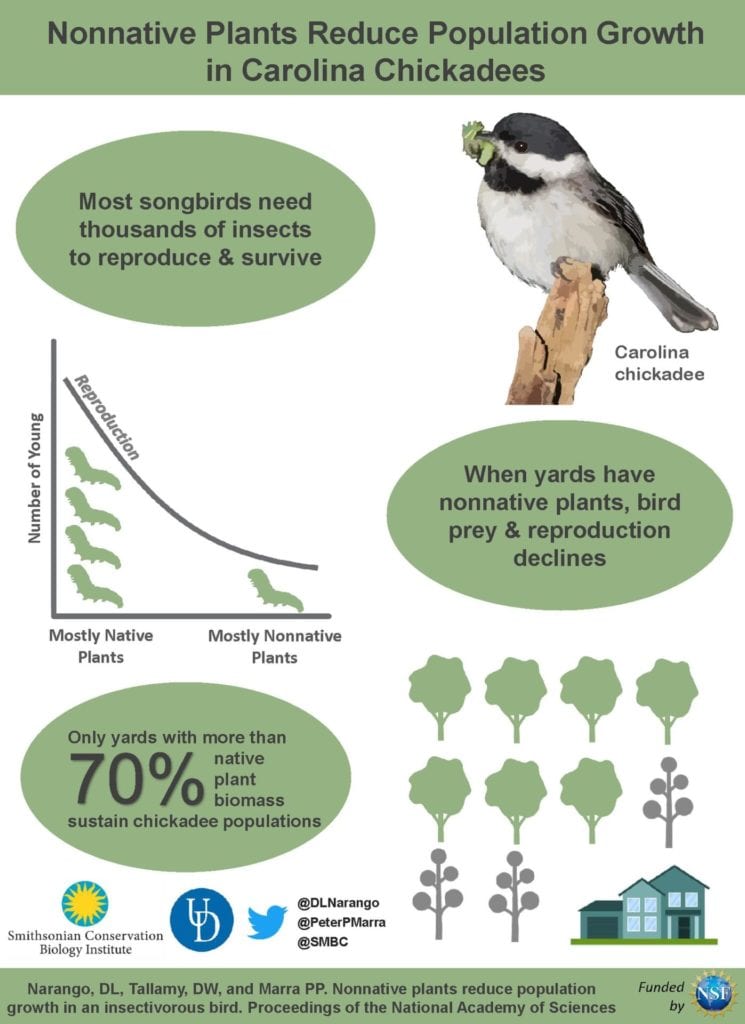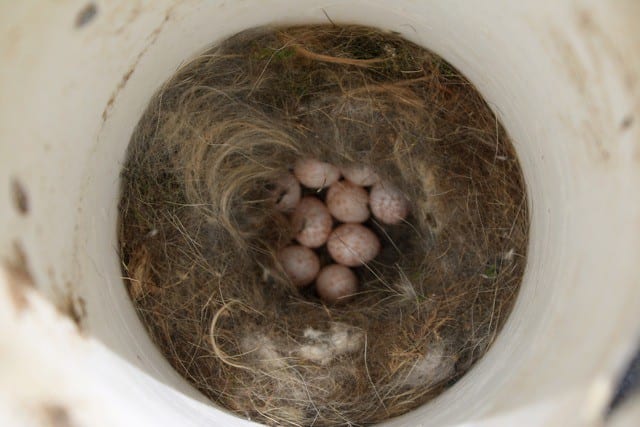Conference Session Review by Melanie Kenney
As humans continue to shape and dominate the landscape, conservationists, land managers, homeowners, landscape professionals, and researchers need information about how wildlife interact with and make use of resources available in urban, suburban, and agricultural green spaces. Dr. Desirée Narango, Postdoctoral Researcher at the City University of New York, Visiting Researcher at the University of Massachusetts, Amherst, and Research Associate with the Smithsonian Migratory Bird Center, presented an exciting new set of research findings focusing on how songbirds navigate, feed, and reproduce in urban and suburban green spaces, using the Carolina chickadee (Poecile carolinensis) as a model insect eater.Dr. Narango’s research seeks to answer the following questions:
- Are urban, suburban, and post-agricultural green spaces useful as habitat for songbirds?
- What are key habitat characteristics that support or threaten songbird populations?
- How can we guide our planting choices to improve songbird habitats?
Songbird Habitat in the Developed Landscape
Birds are as integral to human culture as they are to our landscapes – while we can rely on birds to pollinate plants, perform natural pest-control by eating insects and spiders, and disperse seed over wide areas, birds have also inspired and fascinated us since Paleolithic humans began painting in caves. Now, songbirds are found in art, poetry, and literature, as diverse symbolically as they are biologically. Indeed, birds are excellent indicators of overall biodiversity: studied for centuries, their historic ranges and population sizes are well established, and birds’ sensitivity to ecological disruptions is matched by their rapid adaptive capacity. While wild birds are suffering startling population declines at a global scale, conservation efforts in North America over the last twenty years have exhibited success, triumphs no doubt supplemented by many species’ adoption of urban and residential landscapes as habitat.

Birds are excellent indicators of overall biodiversity. The Carolina chickadee (Poecile carolinensis) is recognized as a “model insectivore:” these little birds are easily recognized, readily nest in prepared nest boxes or other conveniently accessible cavities, and their diets consist of 90% insects.
As we humans continue to shape and mark the North American landscape, a focus on the ecological functions of “urban” forests has emerged, encompassing green areas such as cemeteries, parks, gardens, and street trees. Street trees comprise 50% of urban forest area; at least 80% of forested land in the United States as a whole is owned or managed privately. Urban areas have been well-documented as stopovers for migratory songbirds, attracted for miles by the light from our cities. These urban and suburban spaces, potential songbird habitat, host plant assemblages determined less by biogeography and evolution than by networks of individual decisions made by landowners and land managers. The characteristics of these human-selected habitats are as variable as are individual preferences, though landowners interviewed about the plants on their plots have articulated two key criteria that govern how we select what to plant and what to keep: ease of maintenance and aesthetic value.
The plants that appear in human-designed habitats include a profusion of plants that originated in Europe or Asia rather than North America. The “blame” for this phenomenon isn’t abroad – these foreign woody plants are considered desirable since they do not appeal to most North American insects (“pests”) as a food source. Moreover, non-native plants have been rendered ubiquitous by several centuries of horticultural and landscaping orthodoxy, compounded by some non-native species’ own adaptive capacities and successful dispersal mechanisms.
Habitat Quality and the Plant-Insect Connection
Can urban and suburban landscapes composed largely of non-native or cultivated plants such as tree-of-heaven (Ailanthus), Norway maple (Acer platanoides), and London planetree (Platanus × acerifolia) fulfill the ecological functions necessary to the survival of our songbirds? If habitat is defined as area where birds (in this case) can live, hide, forage, mate, and reproduce with enough success to maintain stable populations, then it follows that urban trees’ ability to supply viable habitat should be evaluated by measuring how well they support songbirds’ life cycles and populations. As it turns out, native trees in general are, on average, much more ecologically functional than non-native and cultivated trees: native trees and shrubs feed and house many more insects and more insect species, and songbirds need insects to eat.
The connections between plant species, insect populations, and bird populations are critical, since songbirds have specific nutritional requirements: 90% of songbirds rely on insects as their primary food source during reproduction, relying on insects’ high protein content to produce eggs and adequately feed their young. When fewer eggs are lain and nestlings are undernourished, juvenile mortality rises, and bird populations decline. In other words, if there aren’t enough insects for parent birds to eat and feed to their young during nesting season, the quality of the habitat is poor. The plants present in our landscapes directly modulate this quality by influencing insect populations: 90% of plant-eating insects, including caterpillars, beetles, and leafhoppers are “specialists” to some degree, meaning that most species can only digest plants belonging to a single species, a single genus, or a single family. In the absence of digestible plants, insects themselves cannot survive or reproduce.
Consider caterpillars, which are the staple of songbird diets during their reproductive periods. In Massachusetts, for instance, there are 2,249 caterpillar species: of these, 20% rely on a single species of plant to feed upon. Another 70% rely on five or fewer plant genera in the state. Creating further complication, caterpillar species able to rely on more than one type of plant may prefer some of their food options over others depending on geographic location. Generally, woody native plants used ornamentally in urban and residential landscapes support far more species of caterpillars than non-native woody ornamental plants. These are the plants we should focus on establishing.
Native Plants Finder, a database compiled by entomologists and ecologists across the country with the support of the National Wildlife Federation, is an excellent resource for those interested in discovering which plants are the most significant hosts for caterpillars in their state or zip code. Oak, the most significant caterpillar host plant in the Eastern US, supports a whopping 477 caterpillar species in Massachusetts. The fifth most significant caterpillar host plant in the state, Poplar, supports 388 species.
By contrast, non-native woody plants in urban landscapes support considerably fewer caterpillar species, fewer caterpillars overall, and fewer specialist caterpillars: Ginkgo supports 6 caterpillar species, Ailanthus 4, Styrax 4, and genera such as Zelkova and Cryptomeria support none at all. These non-native woody plants comprise a hefty portion of the plant biomass in urban habitats, contributing to the suppression of insect populations, and therefore songbird populations. Dr. Narango provides this background information to better contextualize her research on the habits of chickadees in suburban landscapes and urban landscapes; information on her chickadee research follows.
Researching Songbirds in the City: Chickadees as Model Organisms
Given that native woody plants are demonstrated to be more effective in supporting insect populations than non-native woody plants, researchers wanted to investigate the ways in which songbirds interact and survive in human-dominated spaces with variable quantities of both native and non-native trees and shrubs. A handy way to study what might be true of many species within a given group is to select a model organism. Model organisms are plants (like corn) or animals (such as fruit flies) studied and used by scientists because they are convenient to work with and share many traits with subjects that are of comparable or greater scientific interest. The Carolina chickadee (Poecile carolinensis) was selected for research due to its status as a so-called “model insectivore:” these little birds are easily recognized, readily nest in prepared nest boxes or other conveniently accessible cavities, and their diets consist of 90% insects. Researchers can mount cameras in cavity-nests to monitor not only how often chickadees come and go, but also how many eggs they lay, how many eggs hatch, and how many young birds survive to leave the nest.
Additionally, the Carolina chickadee is a handy model to observe in the D.C. metro area (where Dr. Narango’s research was primarily conducted), because their April and May nesting season, the most crucial foraging time, coincides with the arrival and passage of over 50 migratory songbird species. Studying reproductive success among chickadees during this time would help scientists make inferences about food availability, and therefore survival, among the diversity of songbirds that pass through the Mid-Atlantic region during spring migration.
Accessing existing datasets generated through citizen-science, Dr. Narango called upon 18 years’ worth of data collected through the Neighborhood Nestwatch project, headquartered at the Smithsonian Migratory Bird Center, in which citizens of the Washington, D.C. metropolitan area and beyond have monitored the nesting habits and reproductive success of local and migratory songbirds in dozens of back yards, parks, and school properties. Using banding methods common in ornithology, Dr. Narango and her colleagues were also able to capture and release chickadees to monitor the population and to weigh nestlings at crucial stages of development.
Native Plants Support Insects and Songbirds in Human-Dominated Landscapes
Dr. Narango’s study of how chickadees use, forage, reproduce, and survive in suburban landscapes required a strong understanding of the resources available to the local birds: what woody plants do the birds tend to visit, and are these the plants that support the most insect diversity or abundance? Within a 50 meter radius of each observed nesting site, the scientists measured native and non-native woody plant diversity, defining “native” as those plants native to the East Coast of the United States. The species diversity in Dr. Narango’s suburban study plots averaged 29 woody plant species per site, give or take ten. The percentage of non-native woody plant species varied enormously between plots, from less than 1% of all plants in some to 99% in others. The percentage at any given plot depended entirely upon landowners’ preferences.
Dr. Narango also quantified caterpillar abundance and diversity in these suburban study plots to determine food availability for chickadees and other songbirds. Native plants not only support a broader diversity of caterpillar species, but also a greater abundance of caterpillars overall, suggesting that chickadees would likely prefer areas with a greater percentage of native woody plant biomass, which is precisely what the results of the research showed. Chickadees prefer areas with plenty of trees belonging to species that support the greatest quantities of caterpillars – oak, native cherries, birch, willow, and hickory. The birds avoid areas dominated by non-native woody plants, where there are fewer insects available to eat.
 The strength of the relationship between abundance of caterpillars and diversity of caterpillars on host plants means that number of caterpillar species supported by a given woody plant can be used as a proxy for food quality and availability for songbirds. This facilitates the development of ecological models that can integrate landscape characteristics such as percentage of native and non-native plant biomass to predict certain population dynamics of local chickadees and numerous migratory songbirds.
The strength of the relationship between abundance of caterpillars and diversity of caterpillars on host plants means that number of caterpillar species supported by a given woody plant can be used as a proxy for food quality and availability for songbirds. This facilitates the development of ecological models that can integrate landscape characteristics such as percentage of native and non-native plant biomass to predict certain population dynamics of local chickadees and numerous migratory songbirds.
Dr. Narango and her team established that if a tree supports many caterpillar species, it can be assumed that the tree has more caterpillars on it overall (higher insect biomass), and that such a tree will be preferred over other trees by foraging songbirds. More highly-productive caterpillar host plants will be more attractive to birds, and native trees that support high caterpillar diversity are disproportionately important foraging spots for chickadees.

Depending on conditions, juvenile chickadee may stay in the nest longer, taking advantage of its parents’ foraging skills.
The importance of caterpillar and insect abundance can’t be overstated: in order for a nesting pair of chickadees to produce three healthy, 10-gram fledglings by the end of their 16 day nesting cycle, they must supply 390-570 insects PER DAY for their young to survive and leave the nest. Chickadee populations are extremely dependent on the percentage of native plant biomass in a nesting pair’s foraging area: where there is less native plant biomass, there are fewer chickadee nests in the first place, and the nests that are present produce fewer eggs, hatch fewer young, and fledge fewer birds. Dr. Narango’s research determined that to maintain a steady chickadee population size, the landscape used as habitat needs to have about 70% native plant biomass, or no more than 30% non-native plant biomass. When non-native plant biomass exceeds 30%, chickadee populations begin to decline. For reference, the Washington D.C. metropolitan area has an average non-native plant biomass of 55%, while post-agricultural plots in the mid-Atlantic region have more like 80% non-native plant biomass; there is much work to be done.
Sadly, the percentage of native plant biomass needed for chickadees to maintain their numbers is likely less than what is required by other songbirds. Chickadees can maintain their populations under poorer resource conditions than many others: because they nest in boxes and cavities rather than “open cup” nests, chickadee young can stay at home longer, with parents continuing to forage for their offspring until juveniles have reached sufficient maturity to survive alone. Most other songbirds fledge along more rigid timelines, with juveniles leaving the nest whether or not they are physically prepared to survive independently. Most songbird species will remain in decline unless we work to establish significantly more native plants, especially trees, in our now largely human-dominated landscapes.
What next?
Though the current situation may appear bleak, we can immediately start informing our planting and land management decisions to improve the outlook for songbirds. Dr. Narango concluded her session with three highly actionable messages:
- Urban green space seriously matters for songbird populations – these spaces can be targeted for highly consequential conservation efforts by municipal bodies, conservation organizations, community groups, and individual landowners.
- Native tree species that support the most insect species are disproportionately important to songbird populations: planting native oaks, cherries, birches, hickories, poplars, willows, maples, and alders in our gardens and green spaces is the most direct way to improve food availability and habitat quality for songbirds.
- More generally, we should prioritize ecological function when selecting plants and managing landscapes, keeping resources in mind:
- Plant native species that will support native and pollen-specialist bees throughout the growing season;
- Consider the value of three-dimensional structure for wildlife habitat, and include shrub layers in landscape plans;
- When possible, leave leaf litter and pine duff in place during the winter: many moths and butterflies pupate on the ground, hidden and protected by these layers.
More details about Dr. Narango’s research interests and publications can be found on her website: https://desireelnarango.weebly.com
Selected References
- Native Plants Finder: https://www.nwf.org/nativeplantfinder/
- Sustaining America’s urban trees and forests: a Forests on the Edge report. Nowak, David J.; Stein, Susan M.; Randler, Paula B.; Greenfi eld, Eric J.; Comas, Sara J.; Carr, Mary A.; Alig, Ralph J. 2010. Tech. Rep. NRS-62. Newtown Square, PA: U.S. Department of Agriculture, Forest Service, Northern Research Station.
- Urban domestic gardens (X): the extent & structure of the resource in five major cities: Loram, A., Tratalos, J., Warren, P.H. et al. Landscape Ecology (2007) 22: 601. https://doi.org/10.1007/s10980-006-9051-9
- Bringing nature home : how you can sustain wildlife with native plants. Douglas W. Tallamy, Timber Press 2009
- Neighborhood Nestwatch: https://nationalzoo.si.edu/migratory-birds/about-neighborhood-nestwatch
About the Reviewer
Melanie Kenney is an ecologist working as Plant Sales and Plant Records Coordinator at Garden in the Woods in Framingham, MA, the headquarters of Native Plant Trust, whose mission is to conserve and promote New England’s native plants to ensure healthy, biologically diverse landscapes.





